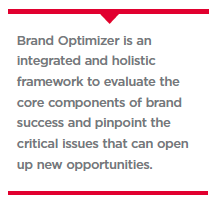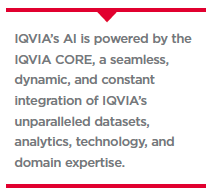Why Managing Brand Performance is So Challenging
 Brand performance appears to be a straightforward concept to understand. However, the reality is that within pharmaceutical organizations, each business function has its own perspective of how brand performance should be planned for, monitored, and improved.
Brand performance appears to be a straightforward concept to understand. However, the reality is that within pharmaceutical organizations, each business function has its own perspective of how brand performance should be planned for, monitored, and improved.
Over the past 15 years, I have used many different definitions for brand performance and a multitude of approaches to improving it. For example, while working with the field sales leadership of a pharma organization, I defined brand performance improvement as the optimization of field force size, structure, call plan, optimal level of detailing, etc. However, while working with the organization’s marketing team, I leveraged a definition of brand performance focused on optimal allocation of promotional budgets across channels for maximizing sales or profits. Similarly, it can be argued that improving managed care contracting is also considered brand performance improvement, and that market share growth indicates better brand performance. The list of viable definitions goes on.
While each business function can be correct in its definition of brand performance, a bigger question arises. Is there is a single framework for measuring the brand performance and a consistent process of improving it? This is the question that many stakeholders have been trying to answer in the industry for a long time.
The IQVIA Brand Performance Framework
At IQVIA, patients are at the center of everything we do, and the framework we employ for measuring and improving brand performance centers around  patients. Specifically, the core pillars of brand performance are patient acquisition — getting the new patients that would benefit most by the brand, and patient retention — treating patients effectively throughout the course of their treatment. Everything else has a direct or indirect influence on these two metrics.
patients. Specifically, the core pillars of brand performance are patient acquisition — getting the new patients that would benefit most by the brand, and patient retention — treating patients effectively throughout the course of their treatment. Everything else has a direct or indirect influence on these two metrics.
The three most direct influencers on patient acquisition and patient retention are payers, providers, and patients themselves, so we need to analyze how these three stakeholders impact the brand performance. Additionally, the indirect impact of Key Opinion Leaders (KOLs) and Integrated Delivery Networks (IDNs) adds complexity. The complexity further increases with the addition of environmental factors that also impact brand performance, such as treatment cost or the level of unmet need in market for a disease state (as shown in image 1).
Appreciating that these influences are interconnected, the standard siloed measurement approach to brand performance leads to sub-optimal results. Therefore, it is critical to create an integrated framework that lets us analyze not only all stakeholders and influences, but also the interwoven dynamics that exist among the influences.
In order to understand the influence of each stakeholder, and to deconstruct the interconnectivity between influencers, an effective framework needs to encompass the strategic improvements that brand teams may achieve. There are only four such improvement levers that brand teams may pursue:
1. Increase the size of treatable patient pool.
2. Increase the number of doctors that are prescribing the product or improve the average volume from existing writers.
3. Ensure scripts are filled at pharmacies.
4. Ensure patients stay compliant to therapy.
We need to understand the underlying issues that are driving the underperformance within any of these four levers. Then we must identify strategies that will help overcome those issues. While there are many strategies that brand teams can deploy to improve any of these four levers, each strategy has a different cost and probability of improving these levers. Identifying the most optimal set of strategies and prioritizing them based on their cost, feasibility, and level of potential improvement in any of these four levers is very challenging. It requires cutting through the extremely complex and large datasets encompassing the entire ecosystem of stakeholders and environmental factors. This is where AI can help.
AI and Brand Performance: Limitations and Opportunities
AI, on its own, probably can’t tell us how to improve brand performance — at least not for now. However, IQVIA’s AI-powered Brand Optimizer solution was designed and developed through a seamless integration of data science and human science expertise. IQVIA’s Brand Performance approach combines subject matter expertise with vast amounts of data in an AI platform to answer the key business questions about which strategies will help improve which performance lever outlined above. In addition, the Brand Optimizer solution is executed and delivered by functional experts with deep knowledge of the nuances of healthcare so that our customers do not have to try to interpret the complex AI results.
This solution has three components that are structured in a way that allows us to assess the potential improvement, identify performance barriers, and develop an actionable mitigation strategy:
1. Forecast Evaluation and Quantification of Expected Improvement: We evaluate a brand’s current forecast by deconstructing TRx or sales forecasts into metrics including required new patients, required new writers, required improvement in adherence, and required improvement in average scripts from existing writers. The required values of such metrics are then compared with current values and their projected trends. This helps to quantify the gap and expected improvement needed in each metric to meet the forecast.
2. Opportunity Identification and Optimization: IQVIA’s AI-based modeling approach allows us to analyze all the drivers of brand performance together in a single model, and to better understand the interdependency that exists between them. We leverage a process that recognizes and accounts for the fact that the drivers that influence new patient acquisition might be very different from drivers that influence patient retention. This process has 3 steps:
a. Identification of the missed opportunity patients: We first identify patients that are not on the brand but share a very similar clinical pathway (sequence of procedures, diagnosis, and prescriptions) to patients currently on the brand. This is our marker for the performance improvement potential that exists in the market.
b. Gap Analysis: Once the opportunity patients are identified, the next step is to understand why these patients are not on the brand. This is achieved through a gap analysis that compares the opportunity patients and current users on hundreds of variables related to messaging strategy, payer access strategy, targeting/promotional strategy, IDN strategy, Thought Leaders strategy, and so on. This gap analysis starts to identify the key parameters on which opportunity patients and current users are different, and helps explain why we missed the opportunity patients.
c. Attribution and Prioritization: In most cases, we find that there are multiple areas that can be improved. What is critical is understanding which investments to prioritize based on their potential impact strategy optimization and the corresponding cost. This can be very complex due to interdependencies between the areas of improvement. Here again, we can leverage IQVIA’s AI to determine the probability of capturing the opportunity patients when specific areas are improved.
3. Strategic Implementation Plan: The results from the above components are analyzed, and insights and recommendations are developed for brand teams. The recommendations provided include very specific action items, together with their predicted impact on improving patient acquisition or retention. This allows brand teams to prioritize their investments and the key areas of focus tied to commercial outcomes.
This framework can be leveraged for brands at varying lifecycle stages, ranging from recently launched brands to more mature brands that are deep into their lifecycles. Regardless of where the brand is in the lifecycle, the insights are extremely powerful. After implementing the recommendations from Brand Optimizer, one of the brand’s reported significant boost in new patient acquisitions. Another brand reported a significant improvement in the ROI of  their promotional investments. Although there is a standardized process and framework that is leveraged to measure and improve performance, the approach is also very flexible and customizable with regards to the variables included and the existing hypothesis and analysis plan.
their promotional investments. Although there is a standardized process and framework that is leveraged to measure and improve performance, the approach is also very flexible and customizable with regards to the variables included and the existing hypothesis and analysis plan.
Brand Performance in the New Environment
With the impact of the COVID-19 pandemic on brand performance, market dynamics have changed so much in a short period of time that it’s often not clear which elements of a brand’s strategy are working or not working. Much uncertainty remains regarding how market conditions will look post-COVID-19. Therefore, it is extremely critical for brand teams to develop a future-ready plan and strategy to measure and improve performance. Powered by industry-leading AI advancements, IQVIA’s Brand Optimizer can help. It energizes growth by providing deeper and evidence-driven insights on where opportunities exist to improve brand performance, how to capture those opportunities, and where to invest to improve brand performance.(PV)
IQVIA is a leading global provider of advanced analytics, technology solutions and contract research services to the life sciences industry.
For more information, visti iqvia.com.

















